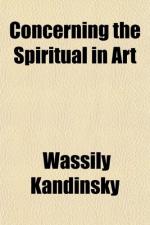As has been said above, Picasso and Kandinsky make an interesting parallel, in that they have developed the art respectively of Cezanne and Gauguin, in a similar direction. On the decision of Picasso’s failure or success rests the distinction between Cezanne and Gauguin, the realist and the symbolist, the painter of externals and the painter of religious feeling. Unless a spiritual value is accorded to Cezanne’s work, unless he is believed to be a religious painter (and religious painters need not paint Madonnas), unless in fact he is paralleled closely with Gauguin, his follower Picasso cannot claim to stand, with Kandinsky, as a prophet of an art of spiritual harmony.
If Kandinsky ever attains his ideal—for he is the first to admit that he has not yet reached his goal—if he ever succeeds in finding a common language of colour and line which shall stand alone as the language of sound and beat stands alone, without recourse to natural form or representation, he will on all hands be hailed as a great innovator, as a champion of the freedom of art. Until such time, it is the duty of those to whom his work has spoken, to bear their testimony. Otherwise he may be condemned as one who has invented a shorthand of his own, and who paints pictures which cannot be understood by those who have not the key of the cipher. In the meantime also it is important that his position should be recognized as a legitimate, almost inevitable outcome of Post-Impressionist tendencies. Such is the recognition this Introduction strives to secure.
MICHAEL T. H. SADLER
REFERENCE
Those interested in the ideas and work of Kandinsky and his fellow artists would do well to consult:
Der Blaue Reiter, vol. i. Piper Verlag, Munich, 10 mk. This sumptuous volume contains articles by Kandinsky, Franz Marc, Arnold Schonberg, etc., together with some musical texts and numerous reproductions—some in colour—of the work of the primitive mosaicists, glass-painters, and sculptors, as well as of more modern artists from Greco to Kandinsky, Marc, and their friends. The choice of illustrations gives an admirable idea of the continuity and steady growth of the new painting, sculpture, and music.
KLANGE. By Wassily Kandinsky. Piper Verlag, Munich, 30 mk. A most beautifully produced book of prose-poems, with a large number of illustrations, many in colour. This is Kandinsky’s most recent work.
Also the back and current numbers of Der Sturm, a weekly paper published in Berlin in the defence of the new art. Illustrations by Marc, Pechstein, le Fauconnier, Delaunay, Kandinsky, etc. Also poems and critical articles. Price per weekly number 25 pfg. Der Sturm has in preparation an album of reproductions of pictures and drawings by Kandinsky.
For Cubism cf. Gleizes et Metzinger, “du Cubisme,” and Guillaume Apollinaire, “Les Peintres Cubistes.” Collection Les Arts. Paris, Figuiere, per vol. 3 fr. 50 c.




